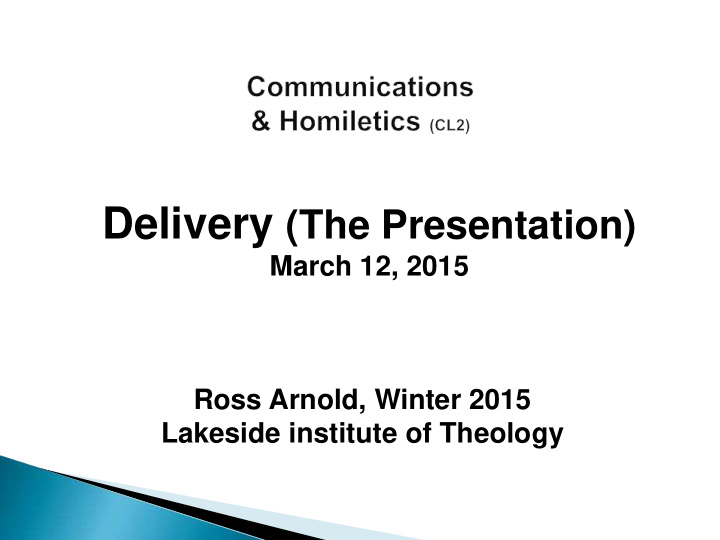



Delivery (The Presentation) March 12, 2015 Ross Arnold, Winter 2015 Lakeside institute of Theology
Communications & Homiletics (CL2) Jan. 29 – Introduction to Rhetoric Feb. 5 – Invention (finding the meaning) Feb. 12 – Arrangement (organizing) Feb. 19 – Style (how to speak) Feb. 26 – No Class Mar. 5 – Memory (preparing to present) Mar. 12 – Delivery (the presentation) Mar. 19 – Applying the Principles; Final Exam
Rhetoric – the use of language (logic + grammar) to instruct & persuade a listener or reader. The Five Canons of Rhetoric (per Aristotle) Invention – evaluating your purpose and developing the argument or message. (What do you want or need to say, and why do you need to say it?) Arrangement – organizing the argument or message for best effect. (How do I structure and organize my message to best communicate with this audience?) Style – determining how best to present the argument or message. (By what approach can I best communicate this message to this audience?) Memory – learning and/or memorizing the argument or message. (How can I be best prepared to effectively deliver this message to this audience?) Delivery – the gestures, pronunciation, tone and pace used when presenting. (In the most practical terms, how can I best present this message?)
Rhetoric – the use of language (logic + grammar) to instruct & persuade a listener or reader. The Five Canons of Rhetoric (per Aristotle) Invention – evaluating your purpose and developing the argument or message. (What do you want or need to say, and why do you need to say it?) Arrangement – organizing the argument or message for best effect. (How do I structure and organize my message to best communicate with this audience?) Style – determining how best to present the argument or message. (By what approach can I best communicate this message to this audience?) Memory – learning and/or memorizing the argument or message. (How can I be best prepared to effectively deliver this message to this audience?) Delivery ( pronuntiatio ) – the gestures, pronunciation, tone and pace used when presenting. (In the most practical terms, how can I best present this message?)
Pronuntiatio /Presentation The discipline of presenting a discourse well. Today the elements of good presentation tend either to be over-emphasized (style over content); or under-emphasized (delivery of accurate content without regard for style). The goal is to find a balance, in which good content is accurately delivered, but good presentation is acknowledged as being critical to the message being well-received, remembered and persuasive. Much of presentation involves good elocution – the study of pronunciation, grammar, style and tone in speaking; and good actio – the use of voice and gestures in oratory.
Practical Approaches to Pronuntiatio 1. People must find you acceptable ( ethos ), so: A. Dignity (dress, stance, posture, gestures) B. Warmth C. Appropriate humor 2. People must be able to hear you A. Projection B. Technical setup (dealing with problems) 3. People must be able to understand you A. Enunciation (no faults) B. Correct pronunciation (no “bad words”) C. Pace and Pitch (phrasing, emphasis) 4. People must believe you ( logos & pathos ) A. Authenticity (eye contact, facial expressions) B. Transparency
Practical Approaches to Pronuntiatio 1. Rehearse your delivery. 2. Practice out loud (listen to yourself) 3. Record your message and listen to it. 4. Practice at normal speed (pause for reactions) 5. Practice at double speed. 6. Practice at half speed. 7. Practice mentally – go through your talk in your mind, thinking about what you will say and how you will say it. 8. Practice in chunks – break the talk down into sections and rehearse these. 9. Practice in front of a live audience.
Practical Approaches to Pronuntiatio 1. Be confident (nothing makes up for lack of self- confidence). 2. Be well-rested. 3. Don’t have a full stomach (it will slow you down). 4. Look the part. 5. Stand behind the podium – don’t lean on it. 6. Arrive early (familiarity, setup, testing, practice, prayer). 7. Sit in all four corners of the room. 8. Visualize yourself speaking. 9. Use deep breathing if you are nervous. 10. Realize that it won’t be perfect.
Recommend
More recommend